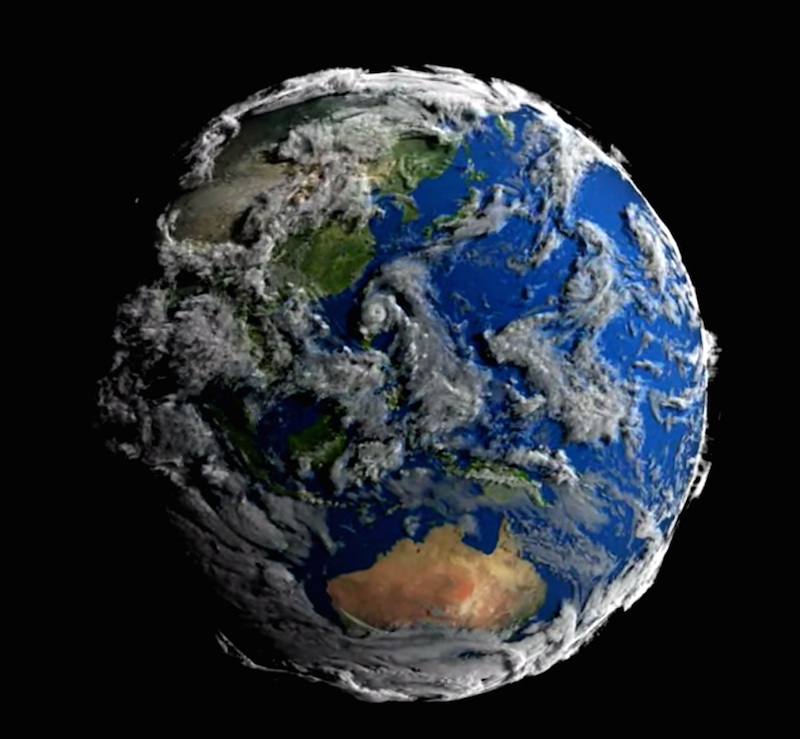Deadly Typhoon Comes to Life in Stunning NASA Simulation (Video)

Van Gogh-esque clouds swirl above planet Earth, trimming coastlines in cottony currents, as one more powerful atmospheric system, a typhoon, spins toward China in a newly released atmospheric simulation created by NASA scientists.
The artistic animation may one day help NASA predict extreme weather with high accuracy, the scientists involved said.
The simulation relies on real-world ocean conditions, but otherwise runs without input from factors that influence the atmosphere, such as wind direction, temperature and moisture.
In the simulated world, a virtual typhoon formed off the coast of China at almost exactly the same time as Typhoon Haitang in July 2005. That is, when the simulation modeled the conditions of July 2005, a typhoon like the real-life one appeared at the same time. Experts attribute four deaths in Taiwan to the 2005 typhoon, which also led to the evacuation of 1 million people along China's coast, NASA reported. [Watch the Animated Video of the Typhoon Simulation]
"The idea is that we produce similar storms, not necessarily the exact storms," William Putman, a research meteorologistat NASA who led the project, told Live Science.
The simulation, called Nature Run 2, is designed to help researchers learn about atmospheric conditions. It has data spanning from May 2005 to May 2007, with samples at every 30-minute interval, according to a NASA statement. For the typhoon simulation, researchers took a seven-day time period to show how a Category-4 typhoon could form in the West Pacific Ocean. In reality, Typhoon Haitang reached Category-5 status with winds reaching 160 mph (257 km/h), NASA reported.
Although not an exact mirror of reality, the model may help researchers learn how they can predict the weather better than they do now. Each 3D pixel, called a voxel, in the simulation conveys factors about the atmosphere, including its temperature, wind speed and direction, pressure and humidity. This may help scientists learn more about hurricanes, typhoons and other storms. (Tropical storms that occur in the Atlantic and Northeast Pacific oceans are called hurricanes, while those storms in the Northwest Pacific are called typhoons.)
Get the world’s most fascinating discoveries delivered straight to your inbox.
Once researchers learn how to accurately forecast the weather in the simulation, they may be able to transfer their new techniques to the real world, Putman said. Studying the factors in the simulation that lead to problematic weather may translate over into the real world and improve weather detection. However, instead of using the simulation data, officials would rely on the atmospheric information that is collected and sent to NASA and the National Weather Service four times a day, and analyze it with techniques gleaned from studying the model.
The simulation may also help researchers find different ways to use current and future satellites that may help them predict the weather, he said.
"We're trying to improve our ability to observe the atmosphere," Putman said. "[The simulation] is a cheaper way of trying to figure out how data can help us in the forecasting world."
The next animation from the Nature Run 2 project will help scientists understand how carbon and carbon dioxide move around the globe, he said.
Follow Laura Geggel on Twitter @LauraGeggeland Google+. Follow Live Science @livescience, Facebook & Google+. Original article on Live Science.

Laura is the managing editor at Live Science. She also runs the archaeology section and the Life's Little Mysteries series. Her work has appeared in The New York Times, Scholastic, Popular Science and Spectrum, a site on autism research. She has won multiple awards from the Society of Professional Journalists and the Washington Newspaper Publishers Association for her reporting at a weekly newspaper near Seattle. Laura holds a bachelor's degree in English literature and psychology from Washington University in St. Louis and a master's degree in science writing from NYU.


